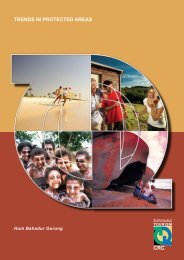icolls - Sustainable Tourism CRC
icolls - Sustainable Tourism CRC
icolls - Sustainable Tourism CRC
Create successful ePaper yourself
Turn your PDF publications into a flip-book with our unique Google optimized e-Paper software.
ECOLOGY, THREATS AND MANAGEMENT OPTIONS FOR SMALL ESTUARIES AND ICOLLS<br />
Elwany, M.H.S., Flick, R.E. & Hamilton, M.M. (2003). ‘Effect of a small southern California lagoon entrance on adjacent<br />
beaches’. Estuaries, 26: 700-708.<br />
Estevez, E.D. (2002). ‘Review and assessment of biotic variables and analytical methods used in estuarine inflow studies’.<br />
Estuaries, 25: 1291-1303.<br />
Falk, C., Hanrahan, L., Anderson, H.A., Kanarek, M.S., Draheim, L., Needham, L., Patterson, D.J. & The Great Lakes<br />
Consortium (1999). ‘Body burden levels of dioxin, furans, and PCBs among frequent consumers of Great Lakes sport<br />
fish’. Environmental Research Section A, 80: S19-S25.<br />
Feller, I.C., Whigham, D.F., McKee, K.L. & Lovelock, C.E. (2003). ‘Nitrogen limitation of growth and nutrient dynamics in<br />
a disturbed mangrove forest, Indian River Lagoon, Florida’. Oecologia, 134: 405-414.<br />
Flindt, M.R., Pardal, M.A., Lillebo, A.I., Martins, I. & Marques, J.C. (1999). ‘Nutrient cycling and plant dynamics in<br />
estuaries: A brief review’. Acta Oecologica, 20: 237-248.<br />
Flores-Verdugo, F.J., Day, J.W.J., Mee, L. & Briseno-Duenas, R. (1988). ‘Phytoplankton production and seasonal biomass<br />
variation of seagrass, Ruppia maritima L., in a tropical Mexican lagoon with an ephemeral inlet’. Estuaries, 11: 51-56.<br />
France, R.L. (1995). ‘Differentiation between littoral and pelagic food webs in lakes using stable carbon isotopes’. Limnology<br />
and Oceanography, 40: 1310-1313.<br />
Froese, R. and Pauly, D. (Eds) (2003). FishBase, accessed 29 January 2004, www.fishbase.org<br />
Froneman, P.W. (2002). ‘Response of the plankton to three different hydrological phases of the temporarily open/closed<br />
Kasouga Estuary, South Africa’. Estuarine, Coastal and Shelf Science, 55: 535-546.<br />
Garcia, A.M., Vieira, J.P. & Winemiller, K.O. (2003). ‘Effects of 1997-1998 El Nino on the dynamics of the shallow-water<br />
fish assemblage of the Patos Lagoon Estuary (Brazil)’. Estuarine, Coastal and Shelf Science, 57: 489-500.<br />
Gaston, G.R., Rakocinski, C.F., Brown, S.S. & Cleveland, C.M. (1998). ‘Trophic function in estuaries: response of<br />
macrobenthos to natural and contaminant gradients’. Marine and Freshwater Research, 49: 833-846.<br />
Gaston, T.F., Kostoglidis, A. & Suthers, I.M. (2004). ‘The 13 C, 15 N and 34 S signatures of a rocky reef planktivorous fish<br />
indicate different coastal discharges of sewage’. Marine and Freshwater Research, 55: 689-699.<br />
Gaughan, D.J. & Potter, I.C. (1995). ‘Composition, distribution and seasonal abundance of zooplankton in a shallow,<br />
seasonally closed estuary in temperate Australia’. Estuarine, Coastal and Shelf Science, 41: 117-135.<br />
Grange, N. & Allanson, B.R. (1995). ‘The influence of freshwater inflow on the nature, amount and distribution of seston in<br />
estuaries of the Eastern Cape, South Africa’. Estuarine, Coastal and Shelf Science, 40: 403-420.<br />
Grant, E. M. (2002). Grant's Guide to Fishes. E.M. Grant Pty Ltd, Brisbane.<br />
Gray, C.A. (2001). ‘Spatial variation in by-catch from a prawn seine-net fishery in a south-east Australian coastal lagoon’.<br />
Marine and Freshwater Research, 52: 987-993.<br />
Gray, C.A. & Kennelly, S.J. (2003). ‘Catch characteristics of the commercial beach-seine fisheries in two Australian barrier<br />
estuaries’. Fisheries Research, 63: 405-422.<br />
Griffiths, S.P. (1999). ‘Consequences of artificially opening coastal lagoons on their fish assemblages’. International Journal<br />
of Salt Lake Research, 8: 307-327.<br />
Griffiths, S.P. (2001a). ‘Factors influencing fish composition in an Australian intermittently open estuary. Is stability salinitydependent?’<br />
Estuarine, Coastal and Shelf Science, 52: 739-751.<br />
Griffiths, S.P. (2001b). ‘Recruitment and growth of juvenile yellowfin bream, Acanthopagrus australis Gunther (Sparidae),<br />
in an Australian intermittently open estuary’. Journal of Applied Ichthyology, 17: 240-243.<br />
Gu, B., Schelske, C.L. & Hoyer, M.V. (1997). ‘Intrapopulation feeding diversity in Blue Tilapia: Evidence from stableisotope<br />
analyses’. Ecology, 78: 2263-2266.<br />
Habron, G. (2003). ‘Role of adaptive management for watershed councils’. Environmental Management, 31: 29-41.<br />
Hadwen, W.L. & Arthington, A.H. (2003). ‘The significance and management implications of perched dune lakes as<br />
swimming and recreation sites on Fraser Island, Australia’. The Journal of <strong>Tourism</strong> Studies, 14.<br />
Hadwen, W.L., Arthington, A.H. & Mosisch, T.D. (2003). ‘The impact of tourism on dune lakes on Fraser Island, Australia’.<br />
Lakes and Reservoirs: Research and Management, 8.<br />
Hadwen, W.L. & Bunn, S.E. (2004). ‘Tourists increase the contribution of autochthonous carbon to littoral zone food webs in<br />
oligotrophic dune lakes’. Marine and Freshwater Research, 55: 701-708.<br />
Hadwen, W.L. & Bunn, S.E. (2005). ‘Food web responses to low-level nutrient and 15 N-tracer additions in the littoral zone of<br />
an oligotrophic dune lake’. Limnology and Oceanography, 50: 1096-1105.<br />
Hall, J.A., Frid, C.L.J. & Gill, M.E. (1997). ‘The response of estuarine fish and benthos to an increasing discharge of sewage<br />
effluent’. Marine Pollution Bulletin, 34: 527-535.<br />
Hall, C.M. (2001). ‘Trends in ocean and coastal tourism: the end of the last frontier?’ Ocean and Coastal Management, 44:<br />
601-618.<br />
Hamilton, S.K., Lewis, W.M.J. & Sippel, S.J. (1992). ‘Energy sources for aquatic animals in the Orinoco River floodplain:<br />
evidence from stable isotopes’. Oecologia, 89: 324-330.<br />
Hamilton, D.P. & Turner, J.V. (2001). ‘Integrating research and management for an urban estuarine system: the Swan-<br />
Canning Estuary, Western Australia’. Hydrological Processes, 15: 2383-2385.<br />
68











